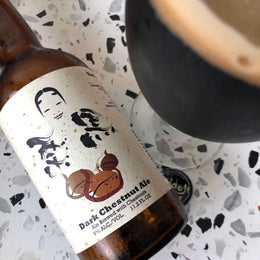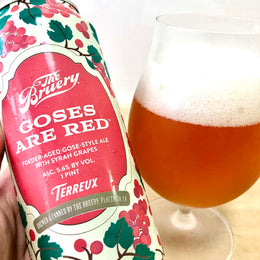The Story Of Brasserie d'Orval, The Princess, The Trout & The Ring; Taste Testing The Iconic Orval Trappist Belgian Pale Ale

"Truly this place is a Val d'Or!"
Or so the legend goes as to explaining how one of the world's most iconic beers curiously has on its label (and bottle cap) a trout holding in its mouth a golden ring, and thus the name Orval. The story goes that a Tuscan princess (or countess by some accounts) by the name of Matilde, had been seated by a spring to rest, when she fatefully dropped her ring into the water. She was distraught and began to pray for the ring to be returned to her - to which, rather miraculously, a trout arose from the calm waters carrying with it the golden ring in its mouth. And thus Princess Matilde exclaimed "Truly this place is Val d'Or!", which can be taken to mean "Valley of Gold". It is thus said that in appreciation for that miraculous event, she would thus have the monastery constructed right where the Abbaye Notre-Dame d'Orval currently resides, in the Gaume region of Belgium, just a kilometer from the French border.


Countess Matilde and the trout.
Yet while we love a good lore, we do have some hard numbers to the history of the Trappist abbey. The monastery that produces the iconic Orval Belgian pale ale was first built in 1070 (that's over 955 years ago!), yet it would face several rocky false starts, at one point being totally destroyed as a result of the French Revolution. It wasn't till 1926 when the Trappist monks had decided that perhaps it would be more economically sensible for them to start with a brewery which could then sustainably fund the abbey before things really got rolling proper. And thus in the serene and peaceful surroundings of forestry, rivers and valleys, would the Orval abbey finally gain ground - beer would be brewed and sold, which in turn allowed the monks to rebuild their abbey using the iconic ochre-coloured pierre de France sandstone that today gives the abbey its distinctive aesthetic.
Now at this point it would be worth digging in alittle into who exactly are these Trappist monks and why are they making beer - and why's that so special! The Trappists (or the Order of Cistercians of the Strict Observance) are a monastic Catholic religious order that branched off from the Cistercians, another prominent religious order. Sometime in the mid-1600's, a French Abbot by the name of Armand Jean le Bouthillier de Rance had introduced reforms which he believed would reinstate strictness to the monasteries, which led to the founding of what would become the Trappist movement, centering itself at the La Trappe Abbey in Normandy - therefore known as the Trappists. These Trappist monks would flee to Belgium during the French Revolution, yet today the order has grown globally, with 13 such abbeys in Europe, and in particular 5 are located in Belgium.

The Orval Abbey.
A core part of the Trappists doctrine revolves around the concept of penitence which sees the monks having to engage in manual labour in order to be self-sustaining. They would therefore make cheese, chocolates, and of course beers! Yet importantly these goods can only be sold with the goal of funding the abbey and also social initiatives such as charities - the abbey is strictly forbidden from making profit as an end goal in and of itself. That's of course just one aspect of their way of life, which also includes a deep focus on self-reflection and therefore minimising contact with people from the outside.
Now where it pertains to beer is particularly interesting - Trappist beers are governed by the International Trappist Association which ensures that the beers are made in a manner that abides by the monastic order's doctrines. Some of the guidelines includes the beers having to be brewed within a Trappist abbey, the brewing of beers having to be second to monastic life, and as mentioned the goal of which being to simply financially support the abbey and charitable initiatives. Yet, interestingly the beers do not have to be brewed by the monks themselves, and also do not dictate a particular style or set of ingredients, and instead focuses more on where it is brewed rather than how it is brewed.

And so getting back to Orval, the abbey very uniquely only makes a single expression - literally Orval, and has done so largely to the same style for about a century! There is a slightly watered down version that's served on draft at the abbey itself, but really there's just one style that the abbey produces - that's some sheer commitment and conviction! Now its worth noting that the monks of Orval have never actually engaged in the beer-making and have always hired layworkers from outside the abbey to produce the beers, and thus the original recipe for the beer was first made by a rather eclectic pair of brewers - a German Martin Pappenheimer, and a Belgian by the name of John Vanhuele, who had trained as a brewer in Britain. It's worth noting that at the time that the Orval beer was being first conceived, the entire goal was simply to produce a beer that would immediately begin to sell so that monies could collected for the abbey to start building itself in earnest - far from any desire to eventually entrench themselves as an iconic beer of the world some 100 years later. And so it wasn't such an insane idea that at the time, the brewers in charge of making the first Orval would simply adapt the beer to what was popular the time, and at the time what was going around was the English Pale Ale. Now of course, the English Pale Ale today is quite vastly different from what it was back then!

Orval was dry-hopping before dry hopping became cool (again).
And thus it was Vanhuele's experience that would come in particularly handy, having made beers for some time in the UK. And so whilst Pappenheimer is often credited for styling the beer as leaning more bitter, it was ultimately Vanhuele who incorporated the English practices of dry-hopping , as well as the use of infusion mashing and that of caramel malts. Yet, perhaps what is most unique about Orval is its use of wild Brettanomyces (specifically Brettanomyces Bruxellensis) yeast which not only gives it a more wild and funky quality, but that also allows the beer to continue to develop in flavour profile long after its bottled! With time, Orval develops more dryness as the yeast eats up any remaining residual sugars, but also develops more effervescence, with a more prominent rustic flavour. Interestingly the use of Brett also allows the beer to potentially pick up a full 1% more ABV as it ages in the bottle, and thus has an ABV that ranges between 5.9% - 7.2%! This makes Orval stand entirely uniquely on its own within the niche but deep world of monastic Trappist ales - it is the only one in fact to use this technique, one that could to some extent be again attributed to Vanhuele's Belgian Flanders' heritage. And thus the Orval we know today was first inaugurated in 1931.

And so what was then a sort of mixtape of various popular styles of the time, had therefore birthed something rather unique, and then layer on top of that a century of staying the same, and today Orval is one of a kind!
Thus with Orval being steadily brewed, the abbey would thus find itself financially able to support itself, which allowed for it to be built to the designs of one Henry Vaes (together with his daughter), who also happened to have designed the special Orval skittle beer bottle shape as well, designed to stop the yeast from being poured into the glass, thus paying consideration to Orval's additional use of wild yeasts in bottle - a unique bottle for a unique beer! Within the first year of its inauguration, Orval beer would begin being shipped internationally by the barrels, and would eventually become the first Trappist beer to be sold nationally around Belgium as well.

And thus for the past almost century, the abbey has sought to preserve the distinct Orval flavours as best as they can, which is no easy feat considering that so much has changed. Working with 35 layman staff in the brewery, the brewers, interestingly led by the first ever female head brewer of a Trappist abbey brewery, Anne-Françoise Pypaert (who first joined the abbey's brewery right out of university in 1992, which might be an unusual choice considering the monastery's vow of celibacy), work closely with the monks of the abbey, meeting with them regularly through the year to present their work, and assuring them of a consistent Orval style. Demonstrably, the abbey keeps a progressiveness and have been open to brewing with more modern equipment, fully updating their brewkit in 2007.
To produce Orval beer, a combination of pale malts (with the barley coming from the Bauce area of France that's then malted in Belgium), caramel malts, alittle bit of black barley, and liquid Belgian candy sugar makes up the grist. This is then boiled for an hour and a half with a changing lineup of hops varieties (in pellets and extracts) ranging from predominantly Hallertau (Germany), Strisselspalt (France) and Styrian Golding (Slovenia), with even the occasional addition of Tomahawk from America's Yakima Valley. This then undergoes a cold fermentation for five days - the particular yeast strain has even been preserved at the University of Leuven as backup, before going into horizontal tanks for three weeks with more yeast (a mixed culture of standard and wild yeasts) and bags of dry hops (in flowers) of once again changing varieties (although largely centered on European varieties). The beer is then bottled, where it then spends a month in a warm room before being released. And thus one of the coolest aspects about Orval is how much of the wild yeast character is felt long after the bottles have been released from the abbey, which then adds a sheen of spontaneity and ever evolving quality about the beer - a young Orval thus tastes markedly different from a well-aged one that's sat in bottle for years even.

And whilst Orval has stayed as unwaveringly faithful to its distinctive style as is humanly possible through the almost 100 years, it is precisely for that reason that the beer has seen its fair share of popular and less popular moments - its bitterness once thought of as too aggressive in a sea of sweet, full-bodied Belgian ales, has now become its biggest selling point. Yet, this commitment to its uniqueness has won Orval the acclaim of numerous highly respected brewers, starting from many of its Belgian brewery peers such as Brasserie Dupont's Olivier DeDeycker, and all the way to America's Russian River Brewing's Vinnie Cilurzo (who popularised the Double IPA with his cult hit Pliny the Elder), New Belgium's Kim Jordan and Allagash's Rob Tod - Orval is undisputedly the brewer's insider beer.
Perhaps what is also particularly surprisingly about Orval too is that only 8% of its beer is today exported outside of the Benelux (Belgium-Netherlands-Luxembourg) area that surrounds the abbey - and in fact half of that 8% that's exported doesn't go far, finding its way to glasses in France. Now, to fully understand how momentous that is, that means that of Orval's 22 million bottles produced annually, set against the Belgian population of 11 million people, puts a theoretical figure at 2 bottles of Orval consumed for every one Belgian person (and that's if we assume children are included in the population figures)!

The very well where Countess Matilde was said to have encountered the trout still resides at the abbey.
Yet it is ultimately key to remember that as a monastic beer brewed with a specific purpose, for every €100 that the brewery earns, €45 goes to social causes with a small amount of that going to the monks to sustain their religious practice. Lastly, if you ever find yourself over at the Orval abbey, be sure to check out the À L’Ange Gardien ("Guardian Angel") cafe which is the only in the world that serves the Petit Orval (or Orval Vert), which is a lighter version of the classic Orval.
With all that said, let's give the iconic Orval a taste! Let's go!
Beer Review: Orval Belgian Trappist Ale

Tasting Notes
Colour: Light Brown
Aroma: Light touches of caramel and more umami savouriness of marmite, along with an increasingly prominent rancio of dried plums and prunes, dried mushrooms, and perhaps more broadly bags of dried foodstuffs. There's also this deep zestiness of dried orange peels, along with that classic spiced quality of cloves and cardamom. It has a sort of mustiness to it that makes it feel rustic and aged, added to which is a slight fermented quality of kombucha yeastiness. Also leather, dried persimmons, and brighter flecks of yellow bananas too. It's a combination of mustiness of dried foods and fruits, with a gentle spiced profile, along with some yeastiness.
Taste: Medium-bodied here, there's still alittle brown sugar and treacle in there, yet it's mostly dry. More umaminess savouriness of marmite, dried mushrooms and old leather. It's ever so delicately sweet with a bigger portion of umami savouriness. It's moderately rich, texturally smooth, and also savoury with a somewhat concentrated quality to the flavours of the body, almost that of dried fruits and preserves.
Finish: More of that clove and cardamom spices emerge, along with also tangerine peels and yellow bananas. It's more estery and fruity into the clean finish. That sweet umami savouriness carries through, yet with more prominent notes of fruit and spice aromatics. Touches of white pepper lingers.

My Thoughts
This is what you'd think of as a rather gourmet beer - something that feels perfect for food pairing. It's very delicately sweet, really mostly dry, yet with these concentrated flavours of dried fruits and musty foodstuffs, as well as all these earthiness of what feels like a bazaar - old leather, exotic spices, fruits of tangerines and bananas. At times it has its moments of being brighter and more multichromatic with these intense flavours of estery fruits, whilst most parts it defers to a umami savouriness of marmite and dried mushrooms, with just some richness of treacle to keep it balanced and approachable. There wasn't much bitterness to be had, with just the right amount of richness and concentration that gives it a sense of having being relatively aged, and so it strays away from being overtly plush and rounded - think dried persimmons with a side of marmite, sprinkled on with some cardamom, and you're pretty close.
Overall its a really complex beer that's also not a hog of attention - it feels comfortable with going with food, leaving space for other flavours to be paired with it. Yet at the same time on its own, there's an abundance in nuances to appreciate about it - the more you sip, the more you discover.
Kanpai!

@111hotpot







